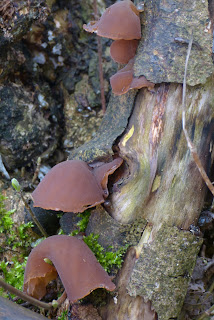For our visit we were invited to survey the woodland and carr, an area that is not normally open to the public.
We assembled in the car park, but no sooner had we got out of the cars to exchange greetings the heavens opened driving us back into them again. The heavy shower soon passed and we managed to get a bit further in our preparations before....
Yes, you've guessed it.
The next heavy shower arrived, this time as hail. Shelter was once again sought in the cars.
It would have been easy to throw in the towel but we are made of sterner stuff!
The showers relented long enough for us to meet our host and his two work experience assistants who gave us an introduction to the site then escorted us onto it.
We were due to be joined on this trip by a group from the Shropshire Wild Teams. Unfortunately a traffic snarl up on the A49 meant that the group could not be collected and only their two leaders managed to get to the site. Let us hope we are able to arrange another date for this group to experience the delights of what we do.
When the weather is wet collecting invertebrates is even more challenging. Equipment soon gets wet and is difficult to handle; any invertebrate caught in it can become water-logged and may be damaged when extracted. So in these conditions the vacuum sampler comes into its own and it was soon brought into use and its catch examined.
This part of the site is very wet. Not only because of the rain! A stream flows into it and as it progresses it breaks up creating several little islands. In addition there are many small pools and very wet areas.
Marsh marigold was in flower in many small clumps.
 |
| Photograph: Jim Cresswell |
 |
| Helophilus sp. - Photograph: Jime Cresswell |
 |
| Photograph: Jim Cresswell |
Two craneflies proved to be common on the day. The first was Tipula vittata, recognised by its distinctive wing pattern and stripes down the side of its abdomen.
The second one was Limnophila schranki - a smaller insect but also with a striking wing pattern. Here we have a male and female.
 |
| Photograph: Jim Cresswell |
In past reports I have often featured photographs of photographers usually when they are in discomfort taking that "one perfect shot". For once someone took a photograph of me taking the photograph of the Tipula vittata above. Fortunately I have not adopted an odd position to take the shot but if I am prepared to include photographs of others I must be prepared to include myself.
 |
| Photograph: JIm Cresswell |
The weather remained changeable all day - heavy rain interspersed with sun - fortunately there was enough sun, and warmth when it came out, to encourage us to stay on site when next shower came along. We took advantage of a longer period of sun to have lunch.
A couple of shieldbug species were found. I did not find any but those that were pointed out to me were taking no chances with the weather they were on leaves of plants with higher leaves acting as umbrellas. What good eyes some people have.
 |
| Green shieldbug - Photograph: David Williams |
 |
| Hawthorn shieldbug - Photograph: Jim Cresswell |
An alder fly was photographed. There are only three species of alder fly in Britain but they all look the same! Identification is based on their reproductive organs so this alder fly cannot be identified to species. That said, the only species I have ever found is Sialis lutaria. Of course this one may have been different. We shall never know.
 |
| Photograph: David Williams |
My thanks to Shropshire County Council for giving us permission to survey in this closed site. My thanks to the photographers for allowing me to share their excellent photographs with you.
































































